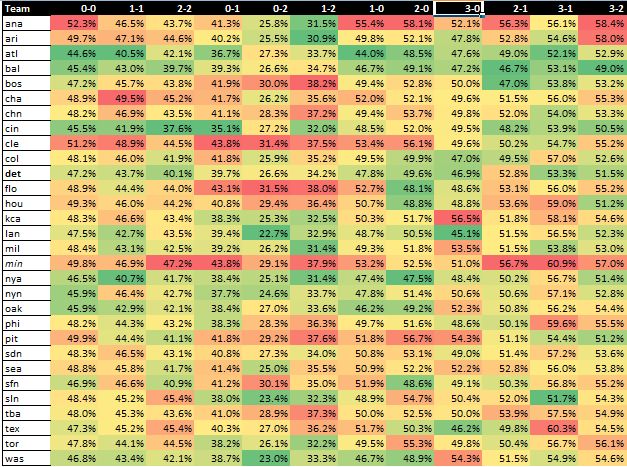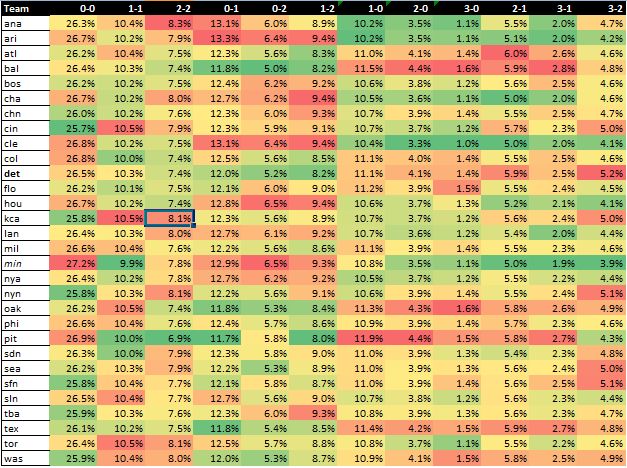In part 1 of the series I dumped some big tables in here that looked at the rate at which teams threw a)strikes and b)the ball in the strike zone. Today we’ll continue along the same path, but we’ll start to differentiate based on count.
Pitches In the Strike Zone by Count
In 2008 teams pitchers through the ball in the strike zone (as defined by pitch f/x) at the following rates:
- 0-0: 48.0%
- 1-1: 45.0%
- 2-2: 43.0%
- 0-1: 40.0%
- 0-2: 27.1%
- 1-2: 34.6%
- 1-0: 49.8%
- 2-0: 51.6%
- 3-0: 49.9%
- 2-1: 51.2%
- 3-1: 55.9%
- 3-2: 53.8%
The table below displays how each team’s pitchers did in each count(click on the table to make it bigger):

My beloved Tigers are below the average across the board. Meanwhile the strike throwing Twins are considerably above average in terms of pounding the strike zone regardless of the count.
Let me pause for a moment to explain the coloring here. Redder colors denote higher values, greener colors lower values, and yellow in the middle. The deeper the color, the farther away from the mid point. (Excel 2007 can do this automatically under conditional formatting. I never had explored this int he 2007 version and I love it).
With the gradient explanation out of the way we can look for some trends.
- The Yankees and Mets tend to keep the ball out of the strike zone more often than not
- Cleveland pounded the strike zone unless they were behind in the count, and then it seemed as if they didn’t want to give in.
- The Angels were the opposite in that they threw it in the zone unless they were ahead in the count.
- The Red Sox pounded the zone when ahead, and stayed away when they were behind, but were fairly neutral with neutral counts.
- The A’s which have had a history of good pitching, didn’t really throw it in the zone too much in 2008
Pitches Thrown by Count
Of course knowing what happens in a particular count is only part of the battle. It’s probably worth looking at how often each team was throwing in a given count (and while we haven’t gotten to the “what happens when the pitch is thrown part” it probably has a bigger impact on performance I’d guess).
Below is the percent of pitches thrown by each team in a given count, with the same lovely shading.

Some stuff I notice here:
- The Twins have the highest percentage of 0-0 pitches, meaning that they are throwing fewer pitches in other counts and having the most short at-bats.
- Despite not throwing a lot of pitches in the zone, the Yankees seemed to work ahead more than behind.
- Baltimore, Oakland, Texas, Washington, Pittsburgh and Detroit threw a lot of pitches from behind in the count. That’s really not surprising.
Conclusions
None yet to speak of, except that if you’re behind in the count your pitching staff probably won’t fare well – but that is kind of a “duh” conclusion. I’m just presenting data at this point. Up next I’ll continue to dive into this and look at which staffs do the best job of getting hitters to go fishing by count.
Interesting stuff.
I was surprised to see that Arizona wasn’t higher than it was. Webb, Haren, and Johnson put up 600 innings of outstanding ball for them this year, and all three of them (especially Johnson and Haren) pound the zone. Maybe the bullpen dragged the stats down for them a little bit.
Another interesting table I’d like to see – pitches by count. Do three categories – fastballs (4FB, 2FB, CFB), breaking balls (CRV, SLD, SCR), and offspeed pitches (CHG, CRC, and SPT). I’d be really curious to see who throws the most fastballs, who pitches backwards the most, etc.
not sure where this comment belongs, but this seems like the place for it. sorry billfer if you’d rather it be somewhere else.
according to mlbtraderumors, the Giants signed Jeremy Affeldt for 2 years, $8 million. It’s a little disappointing not to see DD out after this guy. He could have closed (he allegedly wants to), $4 million per is a reasonable cost, and DD could have even attached an option year to sweeten the deal. All this would have cost a supplemental pick, as Affeldt was type B.
Obviously, I have no idea if DD was in the mix or not, and maybe he doesn’t think Affeldt can close. But I firmly believe that Affeldt would have taken a closing gig in a good pitcher’s park if it was offered to him. This is exactly the type of guy we should be looking at.
I see that the Tigers led the majors in pitches on 3-2 counts. Since they also walked more batters than any other team in the AL on 3-2, I thought I’d look into (AL) outcomes for this count and look for… well, anything. Correlations, lack thereof.
K/BB
LAA .910
TOR .894
CHW .848
BOS .804
NYY .782
OAK .729
KCR .717
MIN .710
AL NORM .710
TBR .708
TEX .656
CLE .641
SEA .610
DET .545
BAL .514
K%
BOS 25.5
TOR 25.3
CHW 24.5
LAA 24.4
NYY 24.4
OAK 23.3
TBR 22.3
AL NORM 22.0
KCR 21.3
SEA 20.8
MIN 20.6
TEX 20.2
CLE 18.9
DET 18.8
BAL 18.3
BB%
LAA 26.8
TOR 28.3
CHW 28.9
MIN 29.0
CLE 29.5
KCR 29.7
OAK 30.6
NYY 30.7
TEX 30.8
AL NORM 31.0
TBR 31.5
BOS 31.7
SEA 34.1
DET 34.5
BAL 35.6
BATTED BALL%
CLE 51.6
MIN 50.4
TEX 49.0
KCR 49.0
LAA 48.8
AL NORM 47.0
DET 46.7
CHW 46.7
TOR 46.4
TBR 46.2
BAL 46.1
OAK 46.1
NYY 45.3
SEA 45.1
BOS 42.8
BABIP
TBR .276
CHW .285
LAA .292
OAK .294
SEA .295
KCR .296
MIN .301
DET .305
AL NORM .305 (probably not exact)
TEX .309
TOR .313
CLE .315
BOS .325
BAL .331
NYY .332
PA/HR
LAA 87.9
BOS 78.5
OAK 68.0
CHW 67.1
KCR 59.6
AL NORM 49.0
DET 48.8
TEX 48.1
NYY 44.8
TOR 44.1
SEA 43.3
TBR 42.2
CLE 41.8
BAL 38.6
MIN 35.1